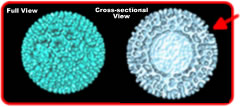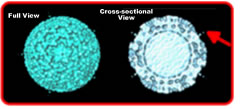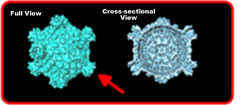Reovirus
is a virus, made up of the proteins coded
by its 10 genes. Two of the proteins are
used as coatings for the virus core, one
protein filament is used to attach to cells
and the rest make up the core. The core manufactures
the mRNA that the cell must make into proteins
so that new reovirus cores and particles
can be put together.
| |
Reovirus
in its natural state
(called
a virion)

Notice
the Sigma1 attachment
filament
|
|
Reovirus
close to cancer cells
(an
infectious particle
called an ISVP)

Notice
the Sigma1 attachment
filament
|
|
Reovirus
inside cancer cells
(called
a core)

Notice
the pore where
mRNA comes from
|
|
|
Reovirus in its natural
state is somewhat protected from the body by a protein coat.
- The coat of proteins cover
tiny points that allow attachment to cells
called the Sigma1 fiber.
- The Sigma1 fiber is what
actually attaches to cells.
- It is also what Reovirus
antibodies (if there are any around) will
attach to and mark the virus for destruction.
The protein coat helps protect the reovirus
from the immune system but at the same time, it makes it hard
for the reovirus to attach to cells.
If the virus approaches a cancerous
tumor, a protein protease from the tumor will dissolve the
outer coating.
- The sigma1 filament
is now fully exposed.
- Sigma1 acts as a drill
to drill though the mucous commonly found
around cancerous cells.
- It attempts to attach
to the proper surface receptors of any
cell that it happens to run into.
At this point, the virus is very exposed
to any of the persons antibodies that may be around. If any
antibodies attach to it, the virus particle will be destroyed
by the immune system.
The process of entering a cell strips
the virus of a second coat of protein and exposes the core.
- The mRNA manufacturing
core of the reovirus is exposed.
- The core at this point
begins producing mRNA that the infected cell
is supposed to automatically convert to proteins
that can be assembled into more reovirus.
The response of the cell and whether or not
it actually converts the mRNA to proteins for the virus depends
very much on the type of cell reovirus has entered (ie. immune
cell, liver cell..) and the state of that cell (ie. is it
at some stage of cell division, is it crawling..).
Additional Info: Importance
of the sigma1 protein glycosidase... or Shiff
website
Graphics Source: Virus
World (use pull down menu)
|